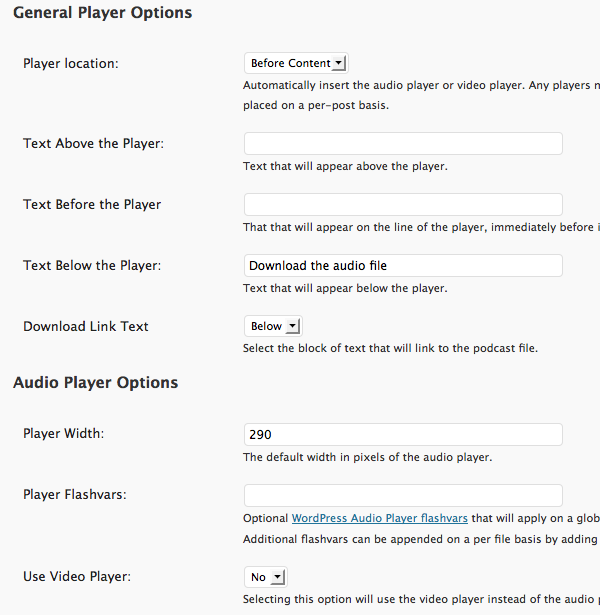Podcasting and Media-rich RSS
This chapter focuses on how the podcasting plug in affects the output of your RSS feed. If you are looking for information on how to get a media player to work, please see the earlier chapters.
What is a podcast?
A podcast can be understood as two things: one is a series of audio files published on the internet. The other is a feed of content as an RSS feed which contains media files as enclosures. Often these meanings are used interchangeably because of the history of the term.
Podcasting first became very popular through a powerful concept. This was the ability for people to subscribe to podcasts to automatically download audio to their iPod or other similar device. For example, iTunes functions as a directory for free and pay content, and there are now many similar podcast directories.
What can Podcasts / Media Rich RSS feeds do for me?
The technology that made this possible was RSS feeds with media enclosures. As this is an open standard, many tools appeared using the same technology for different purposes. The common thread is the use of RSS feed to automatically pull media content from the internet to the home user or to other websites or internet tools.
An example of a tools using RSS
Miro is a Video podcast player which searches for and plays video podcasts in a player that acts like a TV channel browser.
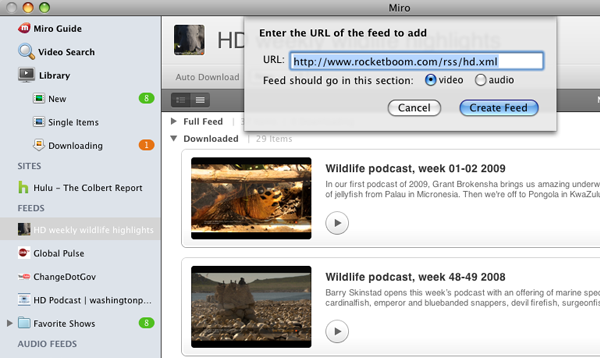
Image aggregation
If you have an RSS feed of your images, those images can be aggregated (displayed) on other websites. WordPress has a special theme that can do this, called Aggregator. The Drupal content management system is also able to do this.
For example we can see here images pulled in from various sites including WordPress blogs all brought together on one site and arranged as a grid.

So we can see that having a website with a RSS feed with media information - be it images, audio or video - is a great way to get your work out there into the network to be seen and re-posted. But what do we have to do to make sure that our RSS feed contains the media that we want it to.
Using the MediaRSS Images plug in
One way of automatically including images in the RSS feed of a site is to use the MediaRSS plug-in for WordPress. Install the plug-in normally and activate the plugin through the Plugins menu. There is more information on the MediaRSS plugin home page. 1
The end result of installing the plug-in can be see in your browser if you point it to the RSS feed of your site, eg - http://yoursite.com/feed. An example is shown below:
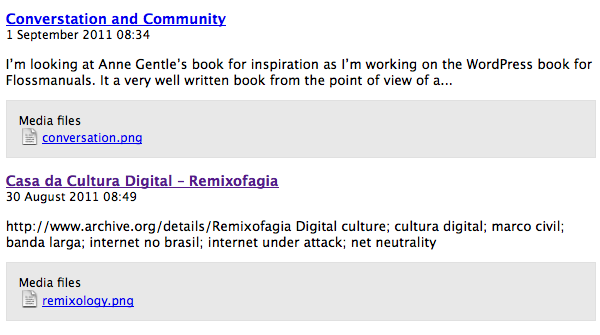
The plug-in looks for media files associated with the post and adds them to the feed using the feed specification called Media RSS.2
<media:content url="http://clearerchannel.org/wordpress/wp-content/uploads/2011/09/conversation.png" medium="image"> <media:title type="html">conversation</media:title> <media:thumbnail url="http://clearerchannel.org/wordpress/wp-content/conversation-150x150.png" /> </media:content>
Audio and video podcasting
Audio and video podcasting is now in built to WordPress. Just link to an audio or video file in one of your posts and WordPress will automatically add the necessary enclosure tag to your RSS2 feed to make it useable as a podcast.
Important: use a complete, absolute URI when linking to the audio file. Otherwise WordPress will not make an enclosure for it.
Wrong: <a href="my-podcast.mp3">My podcast</a> Right: <a href="http://example.com/my-podcast.mp3">My podcast</a>
If you publish this post and then navigate your browser to the RSS feed of your site, you should see the media file mentioned.
If you look at the source of the page and inspect the RSS code, you will see the following in each entry with a media file enclosed. This is the code needed to make our RSS feed into a podcast.
<enclosure url="http://www.archive.org/download/DissidentIslandRadio03December2010/DissidentIslandRadio03-12-10.mp3" length="0" type="audio/mpeg" />
If you have installed the MediaRSS plug-in then your code will be different. Don't worry. It's just using another way of making a podcast. Is worth mentioning as it can add a little bit of functionality to your feed. If you link to a video or audio file in this way, and there is an image associated with your post, then the MediaRSS plugin will add the image as a media:thumbnail element to your feed. It will look like the screenshot below if you examine your feed in a broswer:

This 'rich' feed contains advanced podcast reading tools like Miro and aggregating websites use to be able to display images and other useful bits of information.
Using the Podcasting plug-in
The Podcasting plug-in is a solution you can use on your own site to creating a video or audio podcast. The players used by the plug-in play the following formats: FLV, H.264, MP4, MP3 and AAC.
The plugin does three important things easily:
- inserts a media player into your post
- offers a link to download the media file
- inserts the media file into your RSS feed, thus creating a podcast feed.
Download and install the Podcast plug-in in the normal way.3
You can activate it from the plug-ins page by clicking Activate under the listing of the Pocasting Plugin by TSG.

Then you should navigate to its settings page to add some details about your plug-in and where you want your audio player to appear on the page.
Adding audio to your page
To add an audio player to your page and include an audio file in your podcast you need to add the URL of your audio file to the podcasting box at the bottom of your page when you Add a Post.
Navigate to your new post page in your usual way and look to the bottom of the middle of the page.

Enter the location of your mp3 file in the File URL box of the Podcasting section. Some blogs will let you upload audio files, others may ask you to upload large files to other services like the Internet Archive (archive.org).
You can then add other information to the podcast by filling out the boxes that you are offered.

Choosing where your player appears
You can place the audio player in specific places by using the Send to editor button after entering the URL of your audio file.

Place your cursor where you want the player to appear in your text and then click Send to editor. This means that you can insert multiple players of different audio files in specific places in your post.
When you save the page you should see a result like the following:

Configuring your Podcasting plug-in settings
You can change the podcasting settings to automatically put a player in the page above or below your posts, and to add a download link as well.
From your Dashboard select Settings > Podcasting.
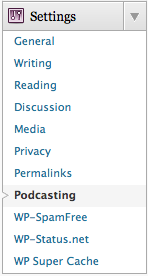
Then you can fill in the basic details about your podcast including its name, an associated image and so on.
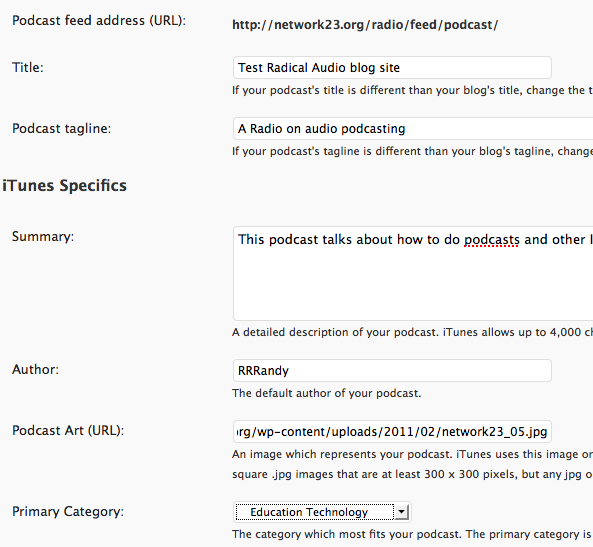
You can then set up how you want the audio player to look on your page. I use the following settings which work well for me. Try them out and alter them if you need to.
Player Location: Before Content
Text Below the Player: Download the audio file
Download Link Text: Below
Player width: 290
Use Video Player: no
